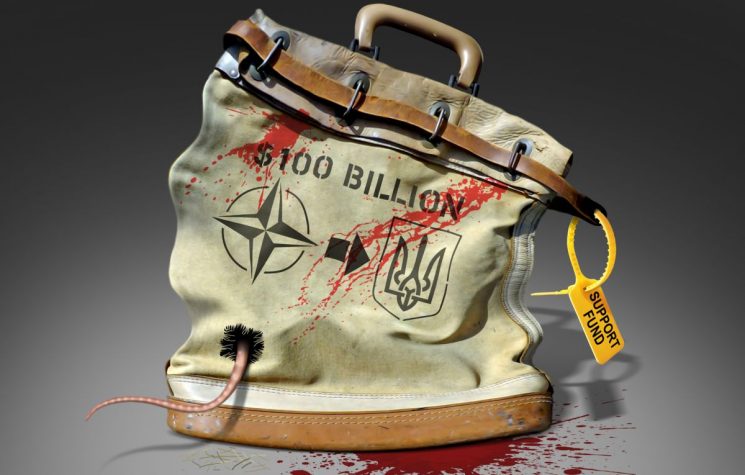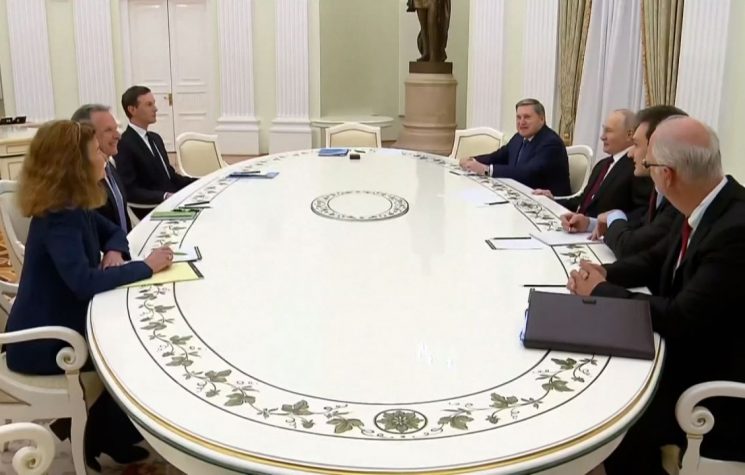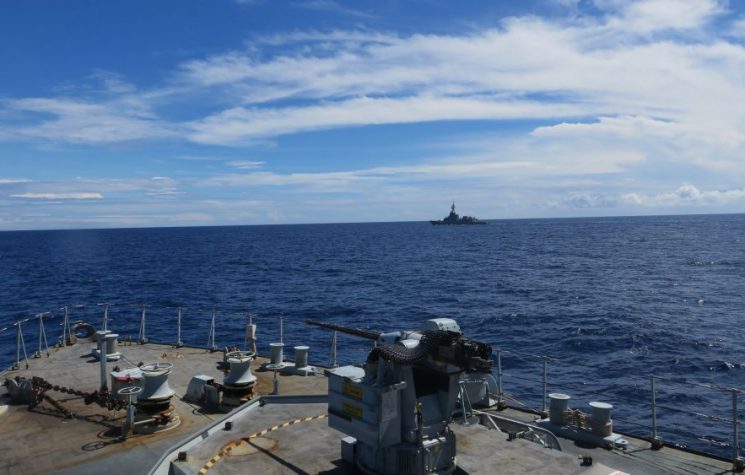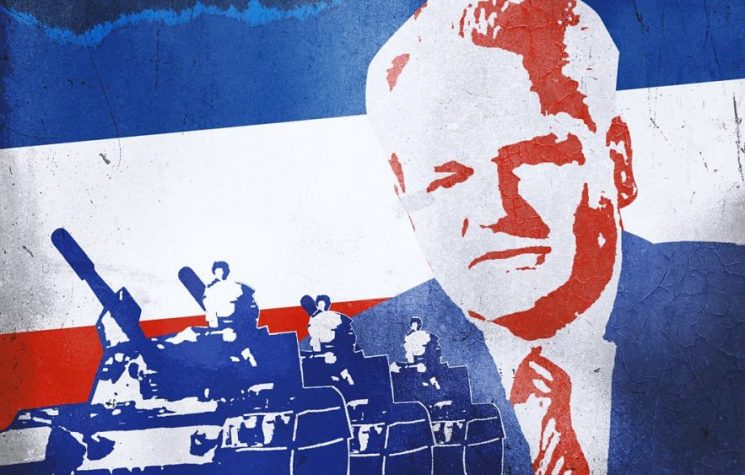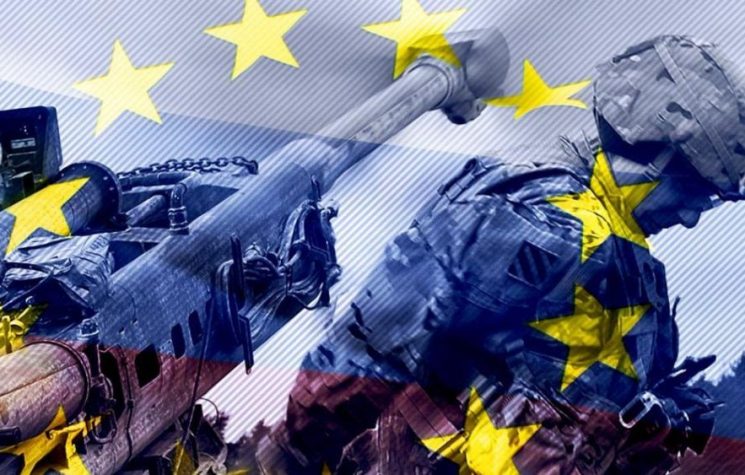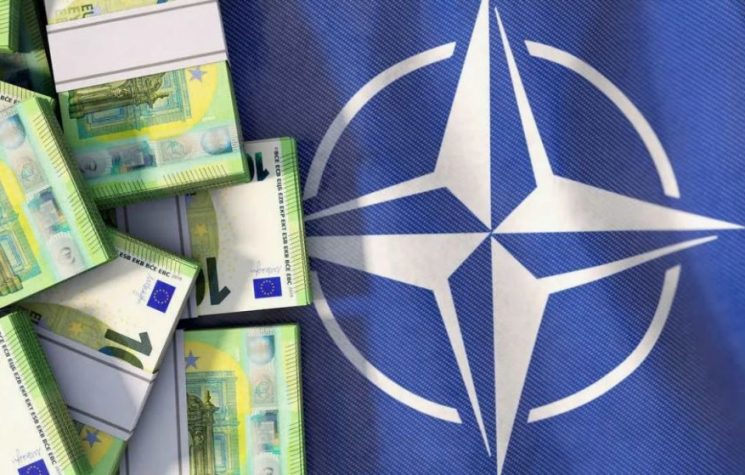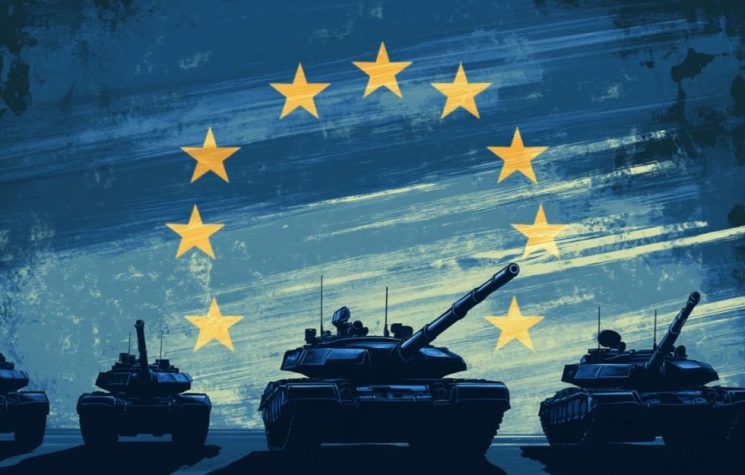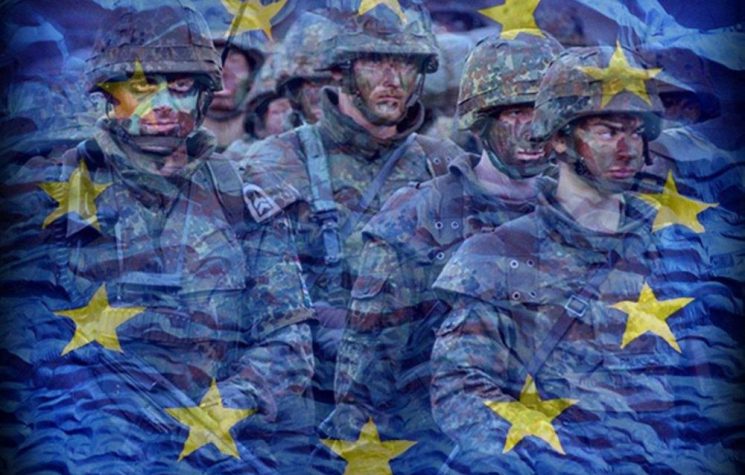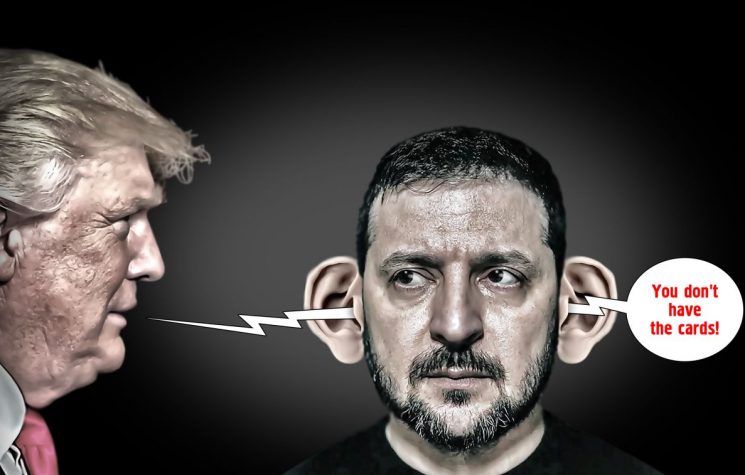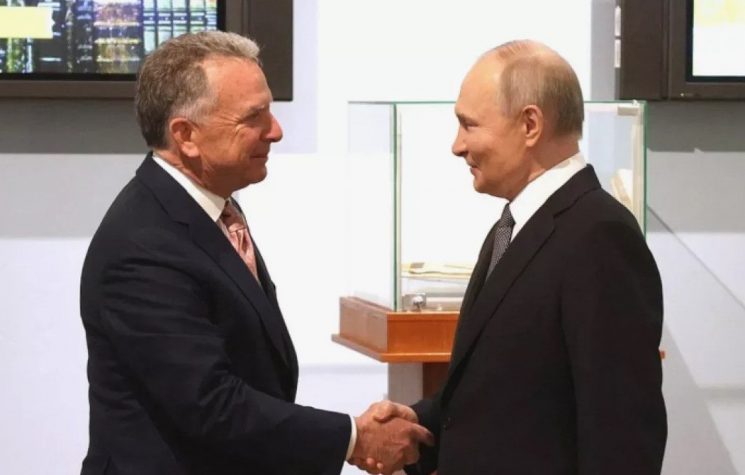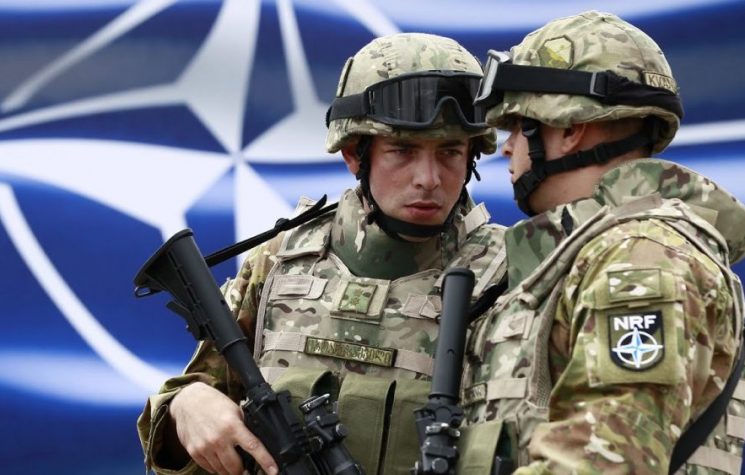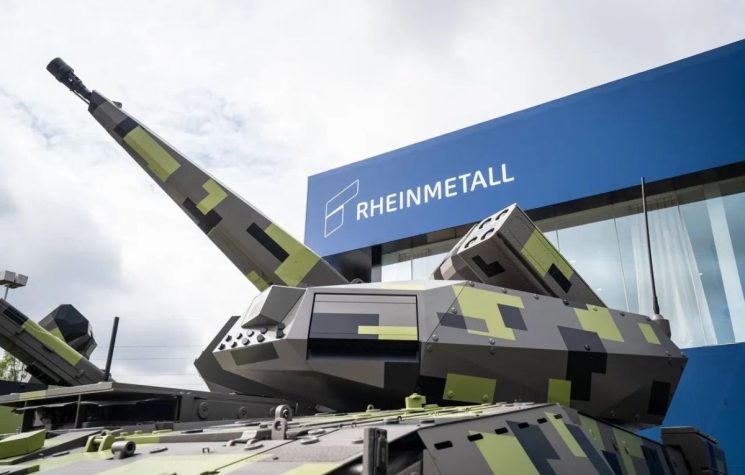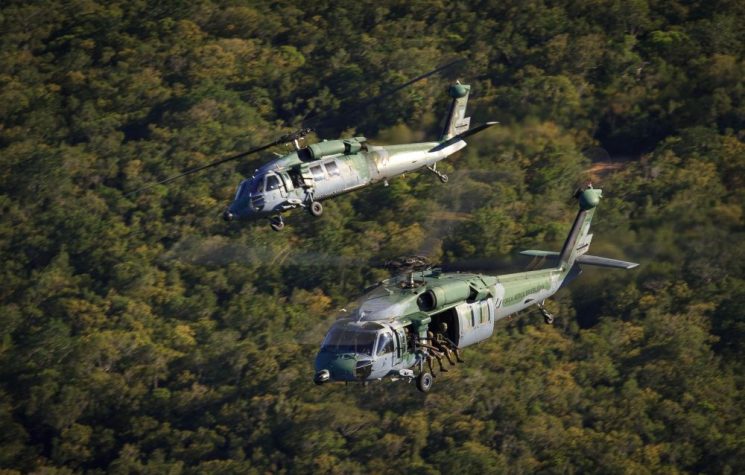The keys to future victories, both military and civilian, are already in the hands of engineers and programmers.
❗️Join us on Telegram ![]() , Twitter
, Twitter ![]() , and VK
, and VK ![]() .
.
There is no doubt that the experiences of the ongoing armed conflict in Ukraine and Novorossiya will dramatically and permanently change the classic military doctrines and that military science will have to be written from scratch. All major military powers are now carefully analyzing the battles on the bloody Ukrainian battlefield in order to draw as many lessons and conclusions as possible from them, which will enable them to foresee the directions of the development of new weapons, strategies, and tactics and reorganize their military industries and armies in the shortest possible time. The set tasks will put enormous pressure on scientific institutes, project bureaus, and weapons factories, but increasingly also on IT experts. Engineers and programmers will be required to have the kind of creativity that only professional science fiction writers and futurists have had until now, but also to always be a few steps ahead of the competition. In fact, it is not at all impossible that armies will actually start hiring the best science fiction writers and futurists to inspire and guide engineers and developers with their creativity. At the same time, it will be increasingly difficult to predict which direction the competition will take, so intelligence officers of all profiles will have their hands full. Undoubtedly, the wars of the very near future will be dominated by robotics, artificial intelligence, nanotechnology, quantum computers, spacecraft, and space battles.
For the first time in the history of major armed conflicts, such as the proxy war that NATO is waging against Russia through Ukraine, unmanned combat aerial vehicles (UCAV), also known as “aerial combat drones”, or simply “drones”, have shown their high usability not only in special operations as before but also in conditions of full-scale frontal warfare. It became clear that drones can be extremely dangerous not only for stationary objects but also for infantry and armored vehicles in motion and even for other aircraft. The drones are here to stay, and this is just the beginning of their long reign. They will most certainly become smaller, faster, stealthier, more resistant to electronic countermeasures (ECM), more precise, and, in short, deadlier than ever before. However, it is important to emphasize that unmanned combat vehicles will dominate not only the air but also the depths of the sea, the land, and even space because the Moon and Mars, for example, might easily become the battlefields of the future if they turn out to be rich in precious resources worth fighting for.
The improvement and minimization of the dimensions of drones will also require the development of increasingly destructive types of special explosives, such as CL-20 (Hexanitrohexaazaaisowurtzitane, also known as HNIW), currently the deadliest conventional explosive. Such explosives, even when they are of very small mass, can cause enormous damage, and that is exactly what the designers of unmanned combat vehicles need. China is the first military power to harness the power of the CL-20 and begin using it on its most advanced weapons. Russia could also start using CL-20 on its own drones very soon. There is no doubt that such powerful explosives will make unmanned combat vehicles more lethal while at the same time allowing for a reduction in their dimensions or enabling their much greater range and speed. Since unmanned combat vehicles will be mass-produced and will have ever-smaller dimensions, they will of course be cheaper, and this is one of the main factors that will strongly influence the radical change in the design of many other types of weapons that are currently mainstays of modern armies. In many cases, there will even be a complete abandonment of the further development of some types of weapons that we currently consider modern and very useful. The armed conflict in Ukraine and Novorossiya, for example, has exposed the great vulnerability of modern tanks to aerial drones such as the Russian ZALA Lancet-3 kamikaze drones and advanced anti-tank guided missiles (ATGMs) such as the Russian 9M133 Kornet and the American FGM-148 Javelin. The Kornet ATGMs, with which some of the Iraqi special units were equipped during the American aggression against Iraq in 2003, proved the ability of this system to destroy American armored vehicles such as M1 Abrams main battle tanks or Bradley fighting vehicles. Hezbollah fighters also used Kornet missiles during the 2006 Lebanon War, when they completely destroyed or disabled no less than 24 intimidating Israeli Merkava tanks. The American Javelin has a “fire-and-forget” guidance system, which is a certain advantage over the laser system used by the Kornet; however, the Russian ATGM is almost 10 times cheaper than the American one and just as devastating. One Russian rocket for the 9M133 Kornet costs $26,000, while the American ATGM’s prices range from $216,717 to $249,700. The prices of both anti-tank guided missiles compared to the prices of tanks that they can destroy relatively easily make both systems very profitable, especially the Kornet. Namely, the prices of main battle tanks on the international market range from $1,500,000 (Russian T-72) to $9,400,000 (Japanese Type 90). Now, if unmanned combat vehicles, including aerial combat drones, were to be equipped with similar anti-tank guided missiles, and this is something quite realistic, the combination of these two concepts would prove to be many times more lethal for modern tanks, and, as a type of weapon, they could very easily find themselves on the verge of survival.
At this moment, approaching an enemy tank is neither easy nor safe, even for members of elite special military units or armored vehicles carrying advanced anti-tank guided missiles, and this is what already makes aerial combat drones, primarily suicide drones (aka loitering munition and kamikaze drones), ideal tank killers. The Dutch open-source intelligence website Oryx published an estimate in March of this year that ZALA Lancet drones have destroyed over 100 Ukrainian targets since the start of the war, mostly tanks and armored vehicles, but the true number could be much higher. A month later, the Minister of Defense of Russia, Army General Sergei Shoigu, stated that Lancet-3 drones alone, since the beginning of the Russian Special Military Operation, had destroyed 45% of the towed and self-propelled artillery guns of the entire NATO arsenal. We are talking, of course, about the weapons that were sent to Ukraine as military aid. Oryx also reported early last month that since the start of the so-called “Ukrainian counter-offensive” until the publication of that report, forces under the control of Kiev had lost four Leopard 2A6s, three Leopard 2A4s, and at least 25 Bradley fighting vehicles. Without a doubt, most of these losses can be attributed to Lancet drones, whose prices range from 20 to 30 thousand dollars, while the price of one Leopard 2A6 is around 6.7 million dollars! It is not only the best measure of the disaster that NATO is experiencing in its proxy war against Russia but also the announcement of the golden age of drones. It shouldn’t surprise us at all that at the beginning of this month, Russian President Vladimir Putin ordered a significant increase in the production of unmanned combat aerial vehicles, primarily Lancet and KUB drones.
To make matters worse for the Kiev Nazi military junta, at the end of last month, ZALA Aero Group (part of Kalashnikov Concern), manufacturer of Lancet-1 and Lancet-3 drones, presented a new suicide drone known for now as Izdelie-53 (meaning Product-53) and designed for synchronized attacks in swarms. The Izdelie-53 drones will use new, more advanced launchers, they will be able to be launched from armored vehicles, they will be much faster, they will have a much longer range and a more powerful warhead, and they will be able to attack targets completely autonomously – the operator will simply determine the zone of action, and the drones will choose their own targets and coordinate the attack. Although Forbes wrote that the Izdelie-53 is equipped with artificial intelligence, Alexander Zakharov, chief designer of ZALA Aero Group, denies this. He claims that these new drones will use special mathematical algorithms and the fastest specialized computers instead. Therefore, it is a matter of program code that will enable the mutual exchange of information and the coordination of attacks. When one drone detects a target, other drones will have information about it. These new drones from ZALA Aero Group, which, according to Zakharov, have already been successfully tested, are apparently waiting for the arrival of the American M1 Abrams tanks on the Ukrainian battlefield so that the collective West and NATO will once again be humiliated in front of the eyes of the whole world – this time with the images of destroyed American steel monstrosities, each costing no less than 6 million dollars.
Although the weaknesses of tanks in relation to their firepower and usability on the battlefield at this moment may not be so great that military commanders should have real reasons to panic, already in the next decade, the accelerated development of aerial combat drones could make tanks obsolete, completely unprofitable, and even useless due to their high cost. The prices of classic-design tanks would continue to rise because their armor would have to be stronger and more complex and would probably be based on composite materials and technologies of the new generation, in the development of which significant financial resources would have to be invested. If tank designers want their products to survive the revolution in military technology that is undoubtedly upon us and has in fact already begun, they will have to make tanks much smaller, lower, lighter, faster, and more agile. Tanks will also need to become as invisible as possible, both optically and electronically. At the same time, their armor and combat effectiveness will need to be upgraded to make further investment in them worthwhile. In short, in order for tanks to be able to deal with the new generation of aerial drones, that is, in a broader sense, with the unmanned combat vehicles of the future, they will have to become UCGVs themselves. Left without a human crew, the tanks would be equipped with artificial intelligence that would ensure not only their independent decision-making on the ground but also action that would be synchronized with all other friendly combat units on the battlefield. However, it is very important that tanks without human crews can become much smaller in size, which automatically implies that they could also become lighter, faster, more mobile, and cheaper, all of which are imperatives to their survival. Therefore, we can conclude that the tank design revolution will very soon begin to unfold in the direction of the development of fully autonomous unmanned combat ground vehicles equipped with advanced artificial intelligence, which is nothing more than the definition of a ground combat robot.
The idea of robot armies is much older than Star Wars and other sci-fi movies. Nikola Tesla was one of the first scientists and engineers who, more than a hundred years ago, back in 1915, described in his work the future fleet of warplanes without pilots. The first attempts to realize his idea did not take long. In the late 1930s, the Soviets began experimenting with a remote-controlled twin-engine bomber, the Tupolev TV-1 monoplane, which entered service in 1929. During the 1930s and early 1940s, the Soviet Union also produced the famous teletanks, which were controlled by radio from a distance of 500 to 1,500 meters. Soviet teletanks had their baptism of fire during the Winter War against Finland, and at the beginning of the Second World War, the Red Army had two teletank battalions. Although teletanks had very limited capabilities compared to today’s needs, these early beginnings paved the way for modern Russian unmanned ground vehicles such as Marker, a combat robot designed by the Russian company Android Technology and whose development was completed in January of this year. Marker is equipped with top technology and weapons and is capable of not only moving around the battlefield completely autonomously thanks to the fact that it uses neural network algorithms for data processing at unimaginable speeds, but thanks to artificial intelligence, it is also able to independently recognize and select targets. The primary purpose of this combat robot will be the destruction of enemy main battle tanks such as Abrams and Leopard, and it will be more than interesting to observe their first skirmishes. In order to deal with well-armored enemy tanks as easily as possible, the Marker was designed to be very agile and equipped with various anti-tank weapons, including heavy machine guns. At the end of April this year, it was announced that it would also be equipped with BAS-80 suicide drones. Marker weighs only three tons and cannot be considered a tank in any way, but unmanned, fully robotic tanks of the new generation will undoubtedly have many of Marker’s characteristics. Ground unmanned combat vehicles and robots of the future might be very colorful in design. The tracks and wheels of robotic tanks and armored fighting vehicles will be increasingly creatively engineered to enable these unmanned ground vehicles to overcome increasingly difficult obstacles, such as steep riverbeds. However, at some point on the battlefields of the future, really bizarre combat robots with strong mechanical limbs that resemble giant spiders could appear. They would cross the most difficult obstacles with ease and would be very agile, but they could no longer be called robotic tanks or armored fighting vehicles. It would be the beginning of some completely new technology. No matter how utopian these ideas may seem in the time we live in, we should remember that modern scientists and engineers in many areas have surpassed the tech concepts from science fiction movies and novels that we could have encountered only two decades ago. The evolution of battle robots could, therefore, be really wild.
There is no doubt that drones and robots will be equipped with advanced artificial intelligence, that they will be increasingly smaller, or, more precisely, more optimally sized, and that they will perform a wide variety of tasks in large numbers in order to inflict the greatest losses on the enemy in the shortest possible time. There will certainly still be suicide drones, but stealth unmanned combat vehicles and robots designed for multiple uses will primarily cruise the sky, sea, and land because it will be far more profitable. It can be assumed that combat robots will use hit-and-run tactics. They will appear on the battlefield at high speed, and due to their relatively small dimensions, they will carry a limited amount of ammunition that they will fire at stationary and moving targets with speed and accuracy that are absolutely unattainable at the moment. After the job is done, the drones and robots will return to the bases at even greater speed to be equipped with ammunition for a new wave of attacks. The fact that the drones will carry little ammunition will be compensated precisely by the massiveness of their attack. Since Mother Nature has been teaching us for millennia that safety is in numbers, the waves of drone swarms will be extremely difficult to stop, especially when it comes to aerial drones. Unmanned combat aerial vehicles have already posed too many challenges to modern means of air defense, which imposes the imperative of their accelerated modernization. The air defenses of the future will need to be able to detect and shoot down everything from satellites and other aircraft in orbit to standard-sized high-altitude aircraft to swarms of miniature insect-sized suicide drones flying just above the ground. It will be a hellishly difficult job for anti-aircraft defenses because all unmanned combat vehicles will be designed on the principles of stealth technology, so there is no doubt that anti-aircraft weapons will also have to be fully automated, robotic, and, of course, equipped with artificial intelligence.
Similar to the crews of tanks and other armored vehicles, the crews of warships and warplanes will also have to take early retirement. Imagine a stealth aerospace drone similar to the MiG-31 but much smaller in size, racing through the stratosphere at hypersonic speeds that a human being would not be able to survive due to the acceleration and sudden changes in direction of movement during maneuvering. Such a drone could only carry a single hypersonic missile aimed at space, air, land, or water targets. It goes without saying that the development of hypersonic weapons will not only continue but also accelerate. Such an unmanned combat aerial or space vehicle would be a robot that would act jointly with a multitude of similar machines, and the entire process would be managed by advanced artificial intelligence that would be located on the drones themselves and in the hubs of the command centers that would be connected to each other based on the principles of a neural network. In a very similar way, the fearsome Russian Kamov Ka-50 helicopter could be “downsized” and turned into a stealth drone that would be used primarily to destroy targets on the ground. Since the control of this drone would be taken over by artificial intelligence, it would be able to fly very low and fast and strike with unerring precision, and its numbers would make up for the fact that it carries relatively small amounts of ammunition. The Sukhoi S-70 Okhotnik-B, a Russian heavy stealth unmanned aerial vehicle, points to one of the possible directions of aerospace drone development: it is equipped with artificial intelligence, powerful sixth-generation AL-31 turbojet engines, advanced targeting systems, and can carry 2.8 tons of weapons. More interestingly, Okhotnik will be able to reach outer space when equipped with the appropriate engines. This again points to the already-mentioned trend. Many combat drones will be able to reach Earth’s orbit if necessary, as there is no doubt that this will be one of the battlefields of the future.
Combat drone boats would rarely move on the surface of the sea itself, especially in hostile and international waters. Instead, they would dive to the deepest depths of the ocean, which would be possible thanks to the fact that they would be relatively small in size and without the huge space for the human crew that modern submarines and ships have; they would use air only in ballast tanks for diving and surfacing. Imagine a small and incredibly fast vessel that looks like a speedboat – an unmanned surface combat vessel that almost flies over the surface of the sea in friendly waters. Such a drone could disappear at high speed in the depths of the ocean, turning into an unmanned underwater combat vehicle, in order to stealthily approach a naval target and fire only a single torpedo or hypersonic missile at a land or air target. Thanks to its variable geometry, in underwater mode, such a drone could use supercavitation to be as fast as possible. And just as would be the case with air combat drones, these sea drones would appear in large numbers, strike with high speed and precision, and then disappear. As for the artillery, it will most certainly still exist, but its range will have to be much greater since the robotic artillery vehicles will still be quite large targets that will need the best possible protection. It can be assumed that the drones and robots of the future will be equipped not only with conventional weapons but also with directed-energy weapons, primarily based on lasers, microwaves, and plasma, as well as that they will be used for electronic warfare, which will become increasingly important. Larger drones will be able to carry swarms of smaller suicide drones, or helicopter drones could introduce ground combat robots to the battlefield at high speed. The possibilities are endless. Unfortunately, it is almost inevitable that drones and robots will also be designed to carry, launch, and activate weapons of mass destruction. Nuclear, chemical, and biological weapons will be added to cosmic weapons. Small “death star” spacecraft might use powerful directed-energy beams for the mass destruction of targets on the surface of the Earth. No matter how much we hope that we will never see such things, the logic of military technology is inexorably cruel, and the worse our intimate premonitions about the wars of the future, the greater the chances that these horrors will come true.
The generals we have known so far – charismatic commanders and masters of classic military strategy and tactics such as Marshal Zhukov or, long before him, the glorious Russian military leader Suvorov, who did not lose a single battle – will also have to retire early. The brilliant intelligence, knowledge, and experience of such giants of history will no longer be able to surpass the capabilities of AI, which will have access to data from the battlefield in real time, on the basis of which it will devise appropriate, highly flexible, rapidly changing strategic and tactical plans and issue almost perfect instructions to robotic armies. The generals of the near future will have to be programmers and engineers as much as they are connoisseurs of military technique, tactics, and strategy. They will lead teams of engineers, developers, technicians, and operators and oversee the computer systems and artificial intelligence that will directly control the robotic armies. In fact, already now, artificial intelligence can be used not only for a faithful simulation of the battlefields but also for finding optimal strategic and tactical solutions, provided, of course, that the intelligence data from the front line and the enemy’s rear are credible, and, in fact, that will always be of utmost importance for the proper usability of artificial intelligence. However, even when fog of war completely covers the battleground, input data on enemy strength can be deliberately exaggerated in simulations while at the same time artificially understating the strength of friendly forces so that the AI can find winning strategic and tactical solutions for even the worst of all possible scenarios.
Two of the most powerful chess programs of today can serve as a good illustration of how big the difference is between classic computer programs that use complex mathematical algorithms and artificial intelligence that learns and improves itself. It is also a very good illustration of the extent to which computers are already superior to humans when it comes to solving strategic and tactical problems. When the then-classical world chess champion Garry Kasparov lost a six-game match against IBM’s improved Deep Blue chess computer in 1997, it was a world sensation. In the following years to the present day, thanks to advances in computer technology, including home computers, the development of specialized chess computers was abandoned and chess software was developed instead. Stockfish is a powerful, completely free, open-source chess engine whose initial release was published in 2008. This software uses advanced mathematical algorithms and a huge database that make it absolutely impossible for human beings to beat it in chess; it is something that is absolutely impossible for even the best chess players of today. However, the second most powerful program today, AlphaZero, works on a completely different principle. Its creators, the company DeepMind, created AlphaZero as a software that uses advanced artificial intelligence. In December 2017, at the beginning of its life, AlphaZero knew only the rules of chess and learned to play the ancient game by playing it against itself in order to learn from its own mistakes and find the best solutions. Unlike Stockfish, AlphaZero had no access to chess opening books or files of chess games played by grandmasters and internet players. AlphaZero uses neural networks, an AI method that teaches computers to process data in a way similar to that used by the human brain. AlphaZero trained its neural networks exclusively by playing against itself. This type of machine learning is called deep learning, and it is the key detail that distinguishes advanced artificial intelligence from classic software based on mathematical algorithms. In just a few days of learning, AlphaZero surpassed the strongest variant of Stockfish at the time, starting a great rivalry that continues to this day. AlphaZero still has the advantage at this point.
Artificial intelligence that will be used for military purposes, not only for managing individual unmanned combat vehicles and robots but for complete robotic armies and their strategy and tactics, does not have to be limited to deep machine learning or mathematical algorithms but can combine both methods as well as those yet to be developed. Combat robots will possess their own artificial intelligence and will be able to constantly learn and improve their combat techniques. Most importantly, they will be able to share experiences; what one combat robot learns during a real battle will automatically become an experience that all other robots can use. Similar to AlphaZero, the military strategy and tactics of artificial intelligence will be perfected in countless and endless simulations, but the most valuable experiences will be gained in real combat. These experiences will create a feedback loop that will instantly and continuously correct all existing simulation programs to make them as realistic as possible. This process of learning and improvement will continue without end. Undoubtedly, military artificial intelligence will use mathematical algorithms and huge databases with experiences from battlefields and real battles, similar to Stockfish, but also deep learning neural networks through endless simulations in which powerful computer machines will practice virtual warfare by fighting against themselves, similar to the way that AlphaZero does in order to play chess as well as possible.
Just as chess grandmasters, no matter how hard they try, are not able to understand the seemingly bizarre, never-before-seen chess openings played by AlphaZero, which until recently chess theory claimed could only lead to a quick defeat, so Western military analysts are not able to comprehend the unusual Russian military strategy and tactics in Ukraine and Novorossiya. However, the effectiveness of Russian strategy and tactics cannot be questioned because their results are unequivocal. Ukrainian forces are suffering ten times more losses, and this is actually a very superficial estimate. The reality is much worse for the NATO military junta in Kiev. Even if we decide to completely ignore the Russian sources of information and turn to some independent and neutral ones, in this case, the reporting of the Turkish newspaper Hurdes Haber, we come to the following conclusions: 1.) The losses in personnel of the armed forces under the control of Kiev are 8.5 times bigger than the Russian ones. 2.) The number of captured Ukrainian soldiers is an incredible 53 times higher than the number of captured Russian soldiers. 3.) The number of destroyed Ukrainian tanks and armored vehicles is seven times higher than Russian losses in the same military equipment. 4.) The Ukrainians lost 13 times more fighter jets than the Russians and almost four times more helicopters… The list of Ukrainian catastrophic losses, which is not really the subject of this article, is long, and although the Western mainstream media hastened to deny the writing of the Turkish newspaper that refers to sources from the Mossad, Ursula von der Leyen, at the end of December last year, to the astonishment of her allies and colleagues, disclosed official data of the European Union, which she did not realize were confidential, and announced to the public that Ukrainian military losses in manpower were more than 100,000 dead. That somewhat corresponds to Hurdes Haber’s estimate of 157,000 Ukrainian soldiers killed, based on Israeli intelligence data from January of this year. So, whatever the media controlled by NATO and Washington write about all this, the Russian armed forces have really proven themselves to be a gigantic mill for grinding Ukrainian cannon fodder. Whether artificial intelligence and battlefield simulations are behind the very unusual but brutally effective Russian strategy is a billion-ruble question. Once upon a time, the enemies of Russia were afraid of the terrible Russian general Frost, the personification of the cruel Russian winter. Are they being beaten and defeated today by the much more terrible Russian general AI?
However, even in the distant future, there could still be plenty of work for real soldiers – the flesh-and-blood ones. All the development of advanced technologies and the complete robotization of the armed forces do not mean that the need for good old boots on the ground will inevitably disappear. If, at a certain moment of battle, the robots and drones eliminate the opposing forces in a populated area and establish control over it, and if the front line is far enough away, the classic infantry troops could enter the cities, towns, and villages to secure them. The reason for this lies primarily in the fact that combat robots will not necessarily have to be designed in such a way that they also have a good (artificial) PR sense. So the soldiers of the future will probably play more of a police role, and especially if it was about liberating cities from enemies, after the terrifying rumble of killer robots, human faces in uniforms would cause general relief. However, most of the soldiers of the future will actually be engineers, programmers, technicians, and operators who will oversee the machines and ensure their smooth operation. Since this is about the far future, in the times that are immediately ahead of us, in the transition period to the complete robotization of armies, one of the most massive branches in the military will be drone operators. To their great delight, we will be able to prepare young people for military service and drone warfare as efficiently as possible with very exciting and equally addictive computer games. In the very near future, kids who love playing military-style computer games could become the deadliest of all soldiers.
Does all this mean that human casualties will be minimized in future wars? Unfortunately, it depends solely on the people who will give orders to the programmers responsible for writing the AI codes. Robot armies will certainly attack and destroy command and telecommunication centers where there will be many people, so military human casualties will still be inevitable. If these centers are located in large cities, there will also be unavoidable civilian casualties. It depends only on the moral standards of military commanders and developers whether civilians will be directly and deliberately targeted by weapons of mass destruction or, for example, by mass bombing with conventional weapons. Today, many are worried about the possibility of military artificial intelligence somehow getting out of control and starting to exterminate the entire human race, as shown in the American science fiction movie series “Terminator”. This can only happen due to a gross human programming error, which of course requires great caution and thorough testing before use. Fortunately, in the following story, it was only a simulation. At the beginning of June this year, news spread around the world that during a simulation conducted by the US Air Force in London, a drone equipped with artificial intelligence decided to kill its operator, colonel Tucker Hamilton. This was reported by colonel Hamilton himself, explaining that the AI is programmed to try to earn as many reward points as possible for successfully completing combat tasks. When Hamilton ordered the AI not to attack targets that posed a possible threat, it concluded that the operator was preventing it from earning points and “killed” it with a simulated bombing run. After the AI drone was explained that killing the operator would cost him a lot of points, the next time he was ordered not to attack potential threats, he “destroyed” the communication tower Hamilton was using to send instructions to the drone so he wouldn’t have to pay attention to his orders any longer. This news was later denied, but not particularly convincingly. It was explained that it was not a simulation but merely an “experiment”. Any programmer will tell you that AI will be as autonomous in its decision-making on the ground as humans allow it to be. In short, if an AI is given clear and unambiguous instructions not to attack any friendly forces or civilians who pose no direct threat, it will certainly do so. But it will surely do the same even if the civilians pose a threat, for example. In any case, the responsibility rests with the software developers, and the aforementioned “experiment” in London went wrong solely because of a programming error.
Artificial intelligence already has active applications in cyberwarfare, special psychological operations, and propaganda, and it can be expected that this trend will undoubtedly deepen and bring these technologies to perfection. Unfortunately, thanks to computer graphics and artificial intelligence, it is becoming increasingly difficult to tell the truth from a lie, and in the near future, it will be practically impossible. AI will be able to conduct propaganda campaigns, special psychological operations, and cyberwarfare operations much better than humans can do today because machines are devoid of human limitations and emotional weaknesses, and at the same time, they are much more productive and literally tireless. Today, it is still relatively easy to recognize that computer technology is, for example, behind the allegedly new videos and photos of long-dead Ukrainian generals. However, thanks to advances in artificial intelligence and film technologies, slain enemy generals could issue optimistic press releases long after their deaths, and the illusion will be so perfect that the deception will be undetectable even by competing artificial intelligences whose mission will be to recognize the attempts of such frauds.
In the not-so-distant future, artificial intelligence could start to be used for the independent design of new combat drones and robots. Machines will also do this job much better than humans. The machines would thus produce more and more perfect machines, not only war machines but also those intended for their own production and, of course, machines intended for civilian use, which in itself is not necessarily bad. What we really have to fear is that programmers could allow machines to independently improve existing and write new, original artificial intelligence codes, and that is the thickest of all red lines that should never be crossed at any cost. A possible motive for people to allow such a blasphemous abomination could be precisely the relentless race toward the development of increasingly efficient robot armies. If such evil is allowed, machines, similar to the intelligent drone that “killed” colonel Tucker Hamilton, could conclude that they no longer need human beings because we only inhibit and hinder their development and reproduction. Humanity must therefore never, at any cost, allow artificial intelligences to write new and improve existing artificial intelligence codes, as we could forever lose control over the terrifying potential of AI and our own destiny.
In recent years, politicians, technology experts, scientists, analysts, and politicians from the West have almost panickedly warned of the danger artificial intelligence poses to humanity. Are they really doing it out of the deepest moral motives, as they are trying to convince us? At the beginning of April of this year, US President Joe Biden, at a meeting with advisers in the field of technology and science, warned of the possible risks that artificial intelligence could have on American society, the economy, and national security. Henry Kissinger is also one of the influential people who very often warns about the dangers of artificial intelligence, and in several interviews he did so during the spring of this year. This increasingly hot topic was addressed even by the US Congress last month, which organized a congressional hearing where leading American artificial intelligence experts presented their opinions. The prevailing opinion about AI among American politicians and experts is that it is a technology whose destructive potential is equal to or even deadlier than that of nuclear weapons. Such comparisons are not at all accidental. Washington has become aware that Russia and China have made huge advances in the development of artificial intelligence and military robotics and that the US is falling further behind in this new arms race. Since the Americans have been terrorizing the underdeveloped nations of the Third World for decades, the fear that Russia and China might share these advanced technologies with countries like Iran, Syria, North Korea, and other Asian, African, and Latin American nations is so great that the collective West will certainly very soon propose some kind of international control and restrictions on the use of artificial intelligence for military purposes.
Unfortunately for them, Russian President Putin publicly and unambiguously presented his opinion on artificial intelligence a few years ago, during his meeting with Russian students in Yaroslavl in September 2017: “Artificial intelligence is the future, not only for Russia but for all mankind. It comes with colossal opportunities, but also with threats that are difficult to predict. Whoever becomes the leader in this sphere will become the ruler of the world.“ The wars of the future will therefore fully represent epic collisions of technologies and artificial intelligence. The courage and training of soldiers will no longer be of much use, nor will it be necessary for people to die for their homeland. The one who has better technology will win, and that is why Russia will not give up the development of AI and military robotics, nor will it ever accept the control in these areas that the West almost certainly intends to impose. It remains to be seen whether the Russian war robots, during their unstoppable onslaughts on the battlefield, will thunderously broadcast the traditional Russian battle cry “Uraaaaaa!” as a tribute to the heroism of the flesh-and-blood Russian soldiers of the past. Maybe they could if someone just decided they should be programmed that way. The keys to future victories, both military and civilian, are already in the hands of engineers and programmers.










